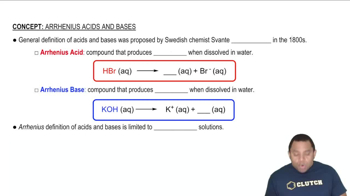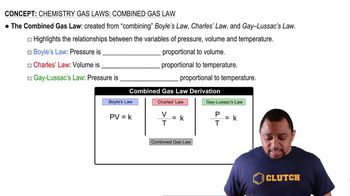Ch.22 - The Main Group Elements
Chapter 22, Problem 166
A 5.00 g quantity of white phosphorus was burned in an excess of oxygen, and the product was dissolved in enough water to make 250.0 mL of solution. (b) What is the pH of the solution? (c) When the solution was treated with an excess of aqueous Ca(NO3)2, a white precipitate was obtained. Write a balanced equation for the reaction and calculate the mass of the precipitate in grams. (d) The precipitate in part (c) was removed, and the solution that remained was treated with an excess of zinc, yielding a colorless gas that was collected at 20 °C and 742 mm Hg. Identify the gas, and determine its volume.
 Verified step by step guidance
Verified step by step guidance1
Step 1: Determine the chemical reaction for the burning of white phosphorus (P4) in oxygen (O2) to form phosphorus pentoxide (P4O10). The balanced equation is: P4 + 5O2 -> P4O10.
Step 2: Calculate the moles of P4 burned using its molar mass. Use the stoichiometry of the reaction to find the moles of P4O10 produced.
Step 3: Dissolve the P4O10 in water to form phosphoric acid (H3PO4). The balanced equation is: P4O10 + 6H2O -> 4H3PO4. Calculate the concentration of H3PO4 in the 250.0 mL solution.
Step 4: For part (c), write the balanced equation for the reaction between H3PO4 and Ca(NO3)2 to form calcium phosphate precipitate: 2H3PO4 + 3Ca(NO3)2 -> Ca3(PO4)2 + 6HNO3. Calculate the mass of Ca3(PO4)2 precipitate using stoichiometry.
Step 5: For part (d), identify the gas produced when the remaining solution is treated with zinc. The reaction is: 2H3PO4 + 3Zn -> 3Zn3(PO4)2 + 3H2. Use the ideal gas law to calculate the volume of hydrogen gas (H2) collected at 20 °C and 742 mm Hg.
Key Concepts
Here are the essential concepts you must grasp in order to answer the question correctly.
Acid-Base Chemistry
Understanding acid-base chemistry is crucial for determining the pH of a solution. White phosphorus (P4) reacts with oxygen to form phosphoric acid (H3PO4) when burned, which contributes to the acidity of the solution. The pH scale measures the concentration of hydrogen ions in a solution, with lower values indicating higher acidity. Calculating the pH requires knowledge of the concentration of H3PO4 produced from the combustion of phosphorus.
Recommended video:
Guided course

Arrhenius Acids and Bases
Precipitation Reactions
Precipitation reactions occur when two soluble salts react to form an insoluble product, or precipitate. In this case, the reaction between the phosphoric acid solution and calcium nitrate (Ca(NO3)2) leads to the formation of calcium phosphate, which is insoluble in water. Writing a balanced chemical equation for this reaction is essential for understanding the stoichiometry involved and for calculating the mass of the precipitate formed.
Recommended video:
Guided course

Selective Precipitation
Gas Laws
Gas laws, particularly the Ideal Gas Law, are fundamental for identifying gases and calculating their volumes under varying conditions of temperature and pressure. In this scenario, the colorless gas produced from the reaction with zinc is likely hydrogen (H2). To determine its volume, the Ideal Gas Law (PV=nRT) can be applied, where P is pressure, V is volume, n is the number of moles, R is the gas constant, and T is temperature in Kelvin.
Recommended video:
Guided course

Combined Gas Law
Related Practice
